Fix: PS4 Error CE-34788-0
The PS4 error CE-34788-0 is an error which usually appears right after your console has downloaded a new update and it appears during boot along the message:
“This update file cannot be used
The update file on your USB device cannot be used. To install an update file from USB, please make sure that you’re using the correct update type:
For a standard update, you’ll need the latest version of the System Software which can be downloaded from eu.playstation.com/get-help/ps4-system-software/.”

There aren’t many ways to solve the problem but the ones we will present below will almost definitely solve the problem if you follow the instructions carefully.
What Causes PS4 Error CE-34788-0?
The most common cause for this problem is a faulty update file that you have downloaded automatically for your console or which you have tried to install manually using a USB storage device and it caused a black screen instead of normal bootup. Fortunately, there is a way to solve it by redownloading the PS4 system completely to a USB device and reinstalling it from there.
Another thing which may solve the problem is simply hard resetting. This works in fewer scenarios but it’s worth giving it a shot as it only takes a minute unlike the method above.
Solution 1: Give Your PlayStation 4 a Hard Reset
Hard resetting a PlayStation 4 device might do it wonders and we recommend you try it out if you ever receive the PS4 error CE-34788-0 when trying to update. This can solve the problem easily without trying to install the whole system again manually and it can only take a minute.
Please follow the steps below carefully in order to achieve the full effect of resetting the PS4 and we hope that you will no longer see the error after you are done!
- Tap and hold the power button at the front part of the Xbox console until it shuts down completely.
- Unplug the power plug from the back of the PS4. Press and hold the power button on the PS4 several times to make sure there is no remaining power and this will actually clean the cache and drain the PS4 from any current. Make sure you leave it disconnected for a couple of minutes.

- Plugin the power brick back and wait for the light located on the power brick to change its color from white to orange.
- Turn the PS4 back on as you would do normally and check to see if the PS4 error CE-34788-0 still appears when you start the console.
Solution 2: Install the Updated System Manually
This might be your only method of solving the problem if the hard reset method doesn’t work since countless users said that the error message vanishes after they downloaded the entire setup for PS4 from their official website and installed it using a USB device.
There is one major downside to this method and that is the fact that you will lose your personal data. Since this is probably your only way of solving the problem, you might want to either accept the fact that you are about to lose your data or you can back it up before performing a hard reset by following this first set of steps.
- You will need to use a USB storage device formatted to either FAT or exFAT. Be sure to fully insert the device into the USB port. Some devices are not compatible due to shape or design.
- From the function screen on your PS4, select Settings and navigate to System > Back up and Restore. Choose the Back Up PS4 option from the new screen.

- Press X to add a checkmark in the Applications saving section.
- Your PS4 will now restart and transfer all the data you have stored. Depending on the amount of data, it could take a couple of hours, to longer than a day.
After taking care of this little problem, you can go and actually reset the PS4 using the file you will download from the PS4 official website. You will still need to use another USB storage device to save the file which should be around 900MB.
- Turn on your computer and create a folder called “PS4”. Open that folder and create another folder called “UPDATE”.
- Download the update file for your PS4 from PlayStation’s official website and move it to the UPDATE folder you just created. Name the file “PS4UPDATE.PUP”. You can download the latest update file by navigating to this location. Scroll down to the bottom and click on “Perform a new installation of the system software”. Locate the Download button.
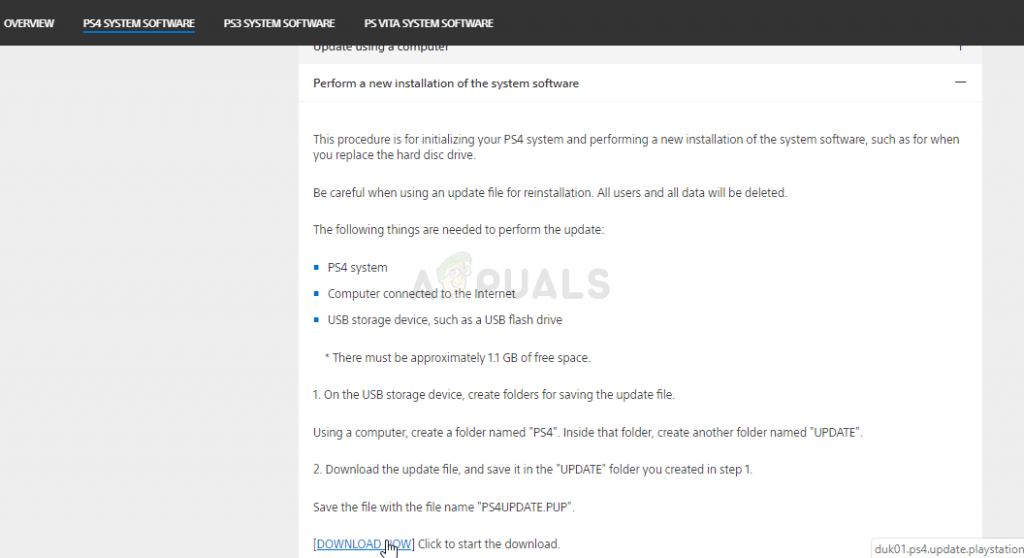
- Move the whole PS4 folder you created on your computer to the root folder of the USB storage device you own. Make sure you have at least 320MB of free space on the USB drive. Connect the USB drive to your PlayStation 4.
- Turn on your PS4, click the PlayStation button to navigate to the function screen and then open Settings >> System Software Update.

- PS4 should automatically recognize the update files if you have named the folders and files correctly. Simply follow the instructions on the screen in order to proceed. If the file is not recognized check to see if you have named and placed the folders correctly in the previous steps.
The last step of this method will consist of actually restoring the backup you have created for your games and user settings. It can be done easily after you reset the software so you shouldn’t worry about losing your data.
- Connect the USB stick you used to back up the game files to the system.
- From the functions screen at the PlayStation 4 home menu, select Settings > Application Saved Data Management > Saved Data on USB Storage Device > Download to System Storage. Select a title.
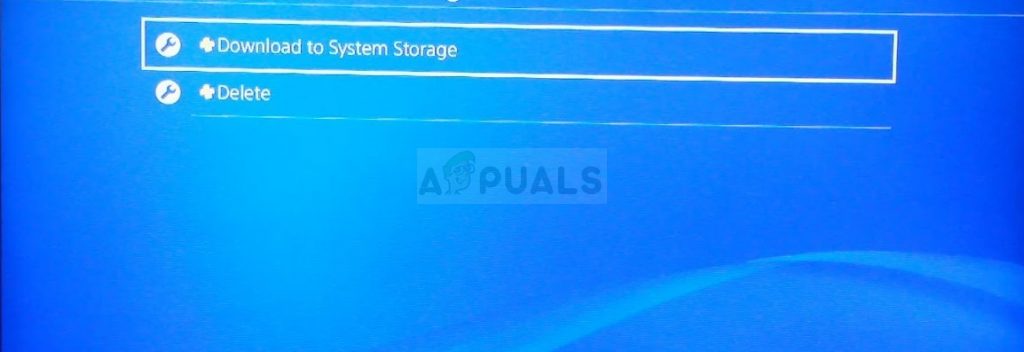
- Press X to add a checkmark in the checkbox for the saved data you want to copy, and then choose Copy. The files should be right there.
Solution 3: Restore the PS4 database
Rebuilding the database can solve a whole lot of problems on PS4 and it can free up plenty of space and can fix most issues. It creates a new database of all the content after cleaning the disc drive. Follow the steps below in order to rebuild the PS4’s Database from the ground up.
- Press the power button on the front panel and shut down the PS4 system. The power indicator will blink for a few seconds before turning off.
- After turning off the PS4 system press and hold the power button again. You will hear a beep sound once you press the button and a second beep seven seconds later to the prior one. Release the button when you hear the second beep sound.
- After this, connect the DUAL SHOCK 4 wireless controller with the USB cable. Then press the PS button on the controller.
- Select the “Rebuild Database” option from the menu by pressing the select button on the controller.
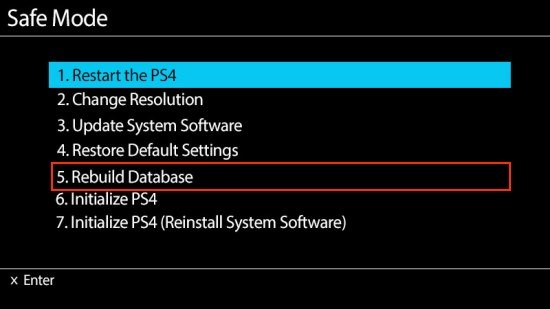
- Wait for a few seconds while it proceeds and then check whether the error is resolved or not.
- If the issue does not get fixed and PS4 loops back into the regular mode after restarting then try updating the PS4 system manually first or hard reset the PS4.
Solution 4: Initialize the PS4 Completely
If your PS4 is crashing continuously resulting in several glitches and errors, you can perform full initialization on your device. This would put back the device to proper working order and would prevent it from malfunctioning again. But initializing the play station fully can erase the data from the console. So be cautious and try to back up your console before performing an initialization so that your data including images, videos, and much more could be saved from erasing. The recommended way for the initialization of PS4 is through the safe mode so we will have to boot into it first. For that:
- Press the power button on the front panel to shut down the PS4. After this, the power indicator will blink for a few seconds before turning off.
- After turning off the PS4 system, press and hold the power button again. You will hear a beep sound once you press the button and a second beep seven seconds later to the prior one. Release the button when you hear the second beep sound.
- After this, connect the DUAL SHOCK 4 wireless controller with the USB cable. Then press the PS button on the controller.
- Select the “Initialize PS4 option” from the list.
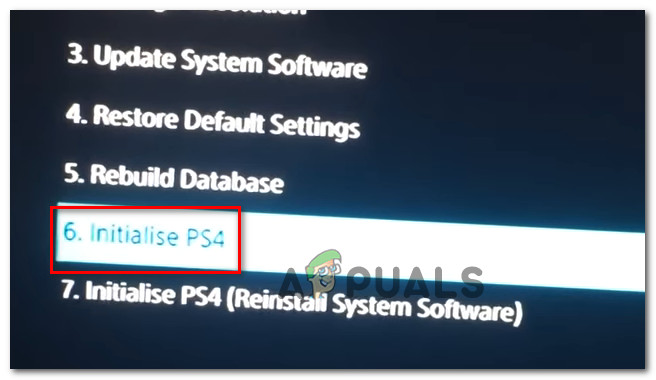
Initialize PS4 - Wait until your PlayStation gets initialized and check to see if the issue persists after completing the process.
Solution 5: Format the PS4 HardDrive
One of the major causes behind the occurring of this error could be malfunctioning and breakdown of the hard drive. This in turn can lead to several glitches and errors which could be problematic to deal with. You can always try upgrading the PS4 hard drive to a newer one but the old one can also get repaired. If the PS4 hard drive would comprise of bad sectors it can lead to the corruption of data and break down of the whole system. Your hard drive may sound like its working properly while containing some bad sectors where optimal data storage just isn’t possible. One remedy for this issue is to try to back up your data since generating multiple copies is the only way your hard drive data could be prevented from getting corrupt and being disintegrated. To eliminate the bad sectors on PS4 hard drive you can connect it to a PC and format it completely to get rid of any faulty partitioning and to remove bad sectors. In addition to this, you can examine its health with a Hard Drive monitoring software to make sure that it is physically up to the mark.
Also, if you are using an external USB or hard drive on the computer, it is recommended that you try and format it as well because it can sometimes contain some corrupted sectors as well. Prior to installing a software update on the PlayStation 4, try resetting the external Harddrive or USB if they are connected.
Solution 6: Reinstall the PS4 firmware
If you need to update your PS4 to the next system firmware you can download it using the Play station website. You can get the update file from here but sometimes the PS4 is not able to properly recognize the operating system after the update and the error message is shown. Therefore, if you have replaced your HardDrive, you will have to completely reinstall the System Software from the PlayStation website to make sure that the OS is working optimally. For that:
- Visit this PlayStation Website and look for the reinstallation file’s download link.
- Click on the option for downloading the “PS4 System Software Reinstallation File“.
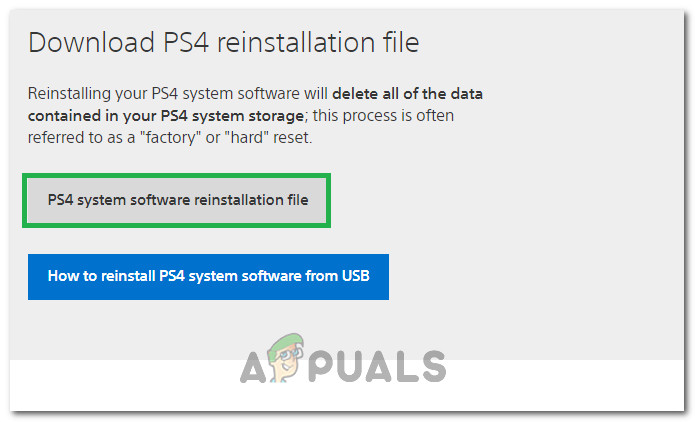
Downloading PS4 Reinstallation File - After clicking on the option, the download should start.
- Wait for the download to be finished, and confirm your file by checking the file sizes. The update file that we have previously downloaded and install would be somewhat closer to 300MB whereas the full install file size would be nearer to 800MB.
- Place this file inside of a USB drive that is formatted to the FAT 32 Format and make sure that you place it as we placed the update file in the solution above.
- Press the power button on the front panel to shut down the PS4. After this, the power indicator will blink for a few seconds before turning off.
- After turning off the PS4 system, press and hold the power button again. You will hear a beep sound once you press the button and a second beep seven seconds later to the prior one. Release the button when you hear the second beep sound.
- After this, connect the DUAL SHOCK 4 wireless controller with the USB cable. Then press the PS button on the controller.
- Once you are done with this and have booted into the safe mode, select the “Initialize PS4 (Reinstall System Software)” option.
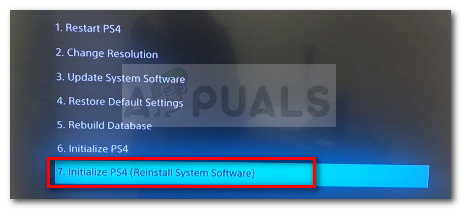
Initialize and restart Ps4 & reinstall software update - Select the Install from USB option and follow the on-screen instructions to reinstall the whole software of the PlayStation 4 from a USB.
- Check to see if this issue still persists after reinstalling the software from scratch.





